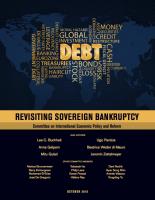Coordinators: Prof. Ugo Panizza (CFD), Lee C. Buchheit (Cleary Gottlieb Steen & Hamilton LLP), Prof. Anna Gelpern (Georgetown), Prof. Mitu Gulati (Duke University), Prof. Beatrice Weder di Mauro (University of Mainz), Dr. Jeromin Zettelmeyer (German Ministry of Economics)
Sovereign debt crises occur regularly and often violently. The recent debt crisis in Greece almost led to the collapse of the Euro. Yet there is no legally and politically recognised procedure for restructuring the debt of bankrupt sovereigns. Procedures of this type have been periodically debated— most recently, about a decade ago, when IMF management proposed a global sovereign debt restructuring mechanism (SDRM). They have so far been rejected. Countries have been reluctant to give up power to supranational rules or institutions. Creditors and debtors have felt that there were sufficient instruments for addressing debt crises at hoc. Importantly, there were also fears that making debt easier to restructure would raise the costs and reduce the amounts of sovereign borrowing in many countries. This was perceived to be against the interests of both the providers of both creditors and major borrowers.




